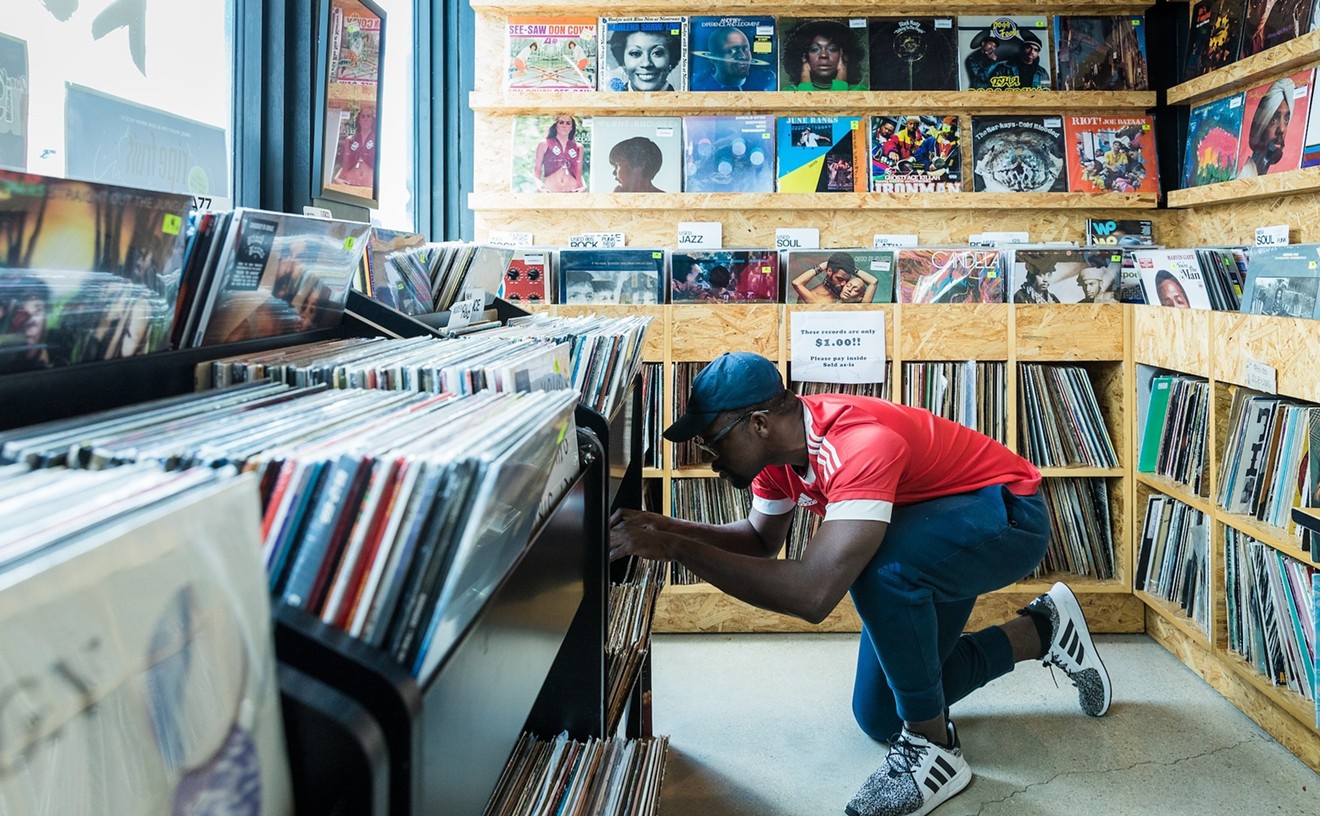But what did they know, really, about Devil worship? Three of the band's four original members were in their teens back in 1982, when first they began to assault the ears of clubgoers in a seedy, run-down Anaheim, California, nightclub dubbed the Woodstock Concert Theatre. Shortly thereafter, in what was probably their first interview, the foursome told a local metal fanzine called the Headbanger they weren't like all the other bands then mixing occult imagery with double-bass-drum/driven musical mayhem -- that they really did conjure up old Lucifer himself with regular rituals. They were the real deal. They were evil personified.
Thousands around the globe would soon join them in the black mass when Slayer began to crank out albums such as Show No Mercy (1983), Hell Awaits (1985), and Live Undead (1985) for the then-fledgling indie, Metal Blade Records. Filled with blood-curdling tales of demonic horror violently fused to the most breakneck heavy metal ever imagined, Slayer set a standard for the speed-metal genre against which all such bands would subsequently be judged.
Maybe it was divine intervention, or maybe they really did sell their souls, but things were going well: European and American tours were booked, T-shirts and posters were sold, albums flew out of Metal Blade's warehouse. Eventually the major labels took notice. Then Rick Rubin, the pioneering rap producer who had often sampled metal records and who oversaw the 1986 collaboration between Aerosmith and Run-D.M.C. for their hit remake of "Walk This Way," became Slayer's omnipotent demigod, stepping in to oversee the band's career.
Rubin stole the band from Metal Blade, signed it to his Def Jam label, and produced Slayer's 1986 effort, Reign in Blood, a 26-minute killer that many consider the definitive speed-metal album (Slayer now records for Rubin's American Recordings). But when the producer delivered the master tapes to Def Jam's distributor, Columbia Records, Rubin and Slayer would discover that even cash-crazed music industry bigwigs wouldn't sell their souls so readily. Columbia refused to release the disc, primarily because of one song, "Angel of Death," a disgustingly graphic tune about Nazi doctor Joseph Mengele. The record was distributed by Geffen; it became the band's first album to hit the charts, reaching the 94 slot.
Slayer would best that first major success and continue to gain notoriety over the course of the next decade, with Rubin at the controls for three of the band's next four records. Now the group's tenth outing, Diabolus in Musica, a brand-new slab of nerve-frazzling, bloodletting, horror-show propaganda, continues the pernicious ceremony. As usual, stories of dread reign supreme, as revealed by such titles such as "Love to Hate," "Death's Head," and "Perversions of Pain." Rapid-fire guitar riffing and remorseless skin beating -- essential to any real speed-metal album -- are predominant. And as any serious Slayer fan would hope, this most relentless of speed-metal bands continues the furious pace with only the slightest trace of an attitude adjustment.
"There's more of an evolution in the writing style," says guitarist and primary lyricist Kerry King of the group's allegiance to the original blueprint. "The sound has pretty much been the same. We try to get a few new sounds on every record rather than make a big left turn and upset the harmony or balance."
Unlike some of their peers. Times have changed for the discontented Metallica fan, for instance, what with that band's shift to radio-ready rock, have-a-cigar bandwagoning, and the clean-cut look. But you're not alone, beleaguered soul: A simple speed-metal fanatic like King can't understand it either. "Metallica says they're doing what they want right now," he says. "If that's the case, that's fine. I think they just took a left turn. You don't go from the Black album [Metallica circa 1991] to some of that crap on that Load record [1997] and expect people to say, 'Oh yeah, I could see where they went from that to that.' No, no, no, no, no. I don't buy that. And I think if credibility is an issue, for me to look at Metallica and go, 'Okay, Master of Puppets, Load.' That's not even an evolution, man. That's like an abortion."
Keep in mind that these two bands were born of the same womb. The Woodstock, at the time the venue of choice for Southern California's speed-metal pioneers, was the breeding ground for both Metallica and Slayer, as well as Megadeth. (And in a strange bit of irony, Radio City, an Anaheim club located next door to the Woodstock, launched the career of Christian metal band Stryper.) Undeniably, the face of music has changed considerably since those glorious days of pandemonium. But if even the once-principled Metallica can forsake their speed-demon roots to flirt with Top 40 radio programmers, what are the hopes for the future of heavy metal? Has alterna-pop warped even Lars's and James's brains?
"I think in the next couple of years people are gonna realize, 'This stuff sucks,'" King predicts, referring not necessarily to Metallica's latest recordings but to the current state of music in general. "They're gonna go back to what's always been cool, and that's heavy music. It's credible. It's always been credible, if you listen to the correct bands. I think it's all gonna come back to that."
Guitarist Jeff Hanneman concurs: "There's always a need for our kind of music. It's an outlet. You can only listen to so much pop and you just have to listen to something heavy. No matter how wimpy you are or how wimpy your attitudes may be, this stuff is just more interesting. We've met so many people you'd never even suspect of being Slayer fans: suits, lawyers, and people like that. And they go, 'I get so frustrated I just have to go put on your records to keep from killing somebody.' We're public servants, basically."
Self-appointed, of course. But at least they've got character, something sorely lacking in so many of today's anonymous one-hit wonders. Shoe-gazing guitar players and lead singers who appear glued to the stage have rendered many a Nineties live concert a total yawn. Has all thought of showmanship deserted us? Not so, says Hanneman. There is hope in the likes of Marilyn Manson.
"Basically he's a little over the top for me," the blond guitarist admits, "but he came along at a time that really needed it, because some of these bands are so bland. They have no personality."
When reminded that some people have long considered Slayer "over the top," Hanneman is quick to blurt, "Yeah, but we don't wear women's clothing," as if his manhood were in jeopardy simply by comparison. Of course, clothing doesn't make the man or the band. Nor do the horrific stage props of a rock and roll torture chamber the likes of Manson's or sometimes even Slayer's, if the music isn't happening. Regardless of the ghoulish gimmickry, people don't go see bands like Slayer just to see them.
"If I was a Slayer fan, that's not what I'm going to see," Hanneman says of the band's on-stage theatrics. "It's the aggressiveness of the music combined with the aggressiveness of the crowd, the sweat, the lights. It's not so much theatrics as it is basic raw energy."
With so much raw, energetic aggression inciting the predominantly young male audiences, though, some thought has to be given to the consequences of firing up a crowd as do Hanneman, King, vocalist and bassist Tom Araya, and drummer Paul Bostaph (who replaced original skin-beater Dave Lombardo in 1994). But King says he's not too concerned about his fans taking the band or its lyrical content too seriously.
"I'm always straight up-front about it. If they like us enough to like the music, they probably read most of the interviews. I don't lie in the press every day. If you want to know what the songs are about just do a little homework and I'm sure you'll find out. There's always -- I'll just throw out a number -- five percent outer fringe that are just tweaked anyway. No matter how many times you tell them what it's about they'll tell you, 'No, you're wrong.'"
King finds that kind of behavior especially irritating because, despite what he or his mates may have told Headbanger magazine about Devil worshipping all those years ago, today he claims it's really just entertainment. He's not trying to establish a point of view, just a little mental imagery. And he's not doing any recruiting for anyone, not even the antichrist.
"I'm not a preacher. I don't say, 'Think like this,' and I don't appreciate bands doing that, because a lot of them don't realize how much power they have over their audience. They can influence masses of people to think like them just because they said something. I think it's bullshit. I never wanted to be a preacher. Ninety percent of the stuff I write is fantasy.










